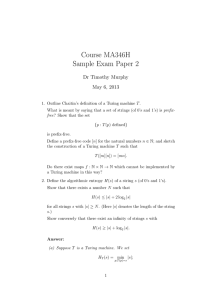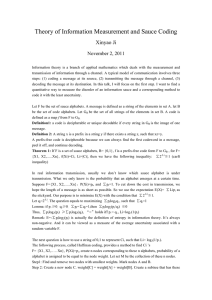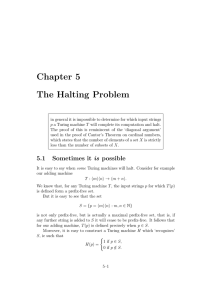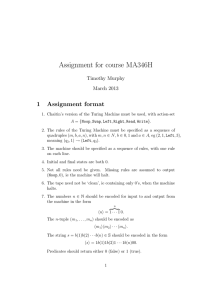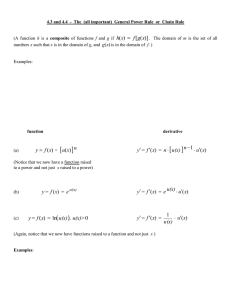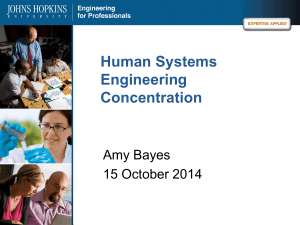Chapter 2 Prefix-free codes 2.1 Domain of definition
advertisement
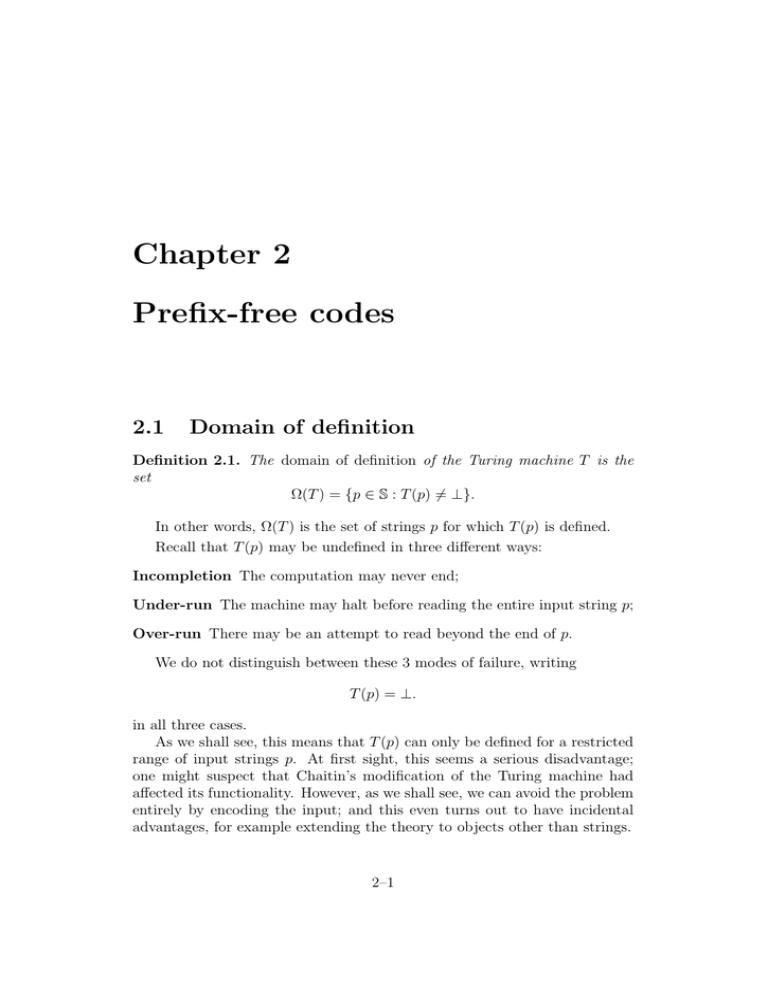
Chapter 2
Prefix-free codes
2.1
Domain of definition
Definition 2.1. The domain of definition of the Turing machine T is the
set
Ω(T ) = {p ∈ S : T (p) 6= ⊥}.
In other words, Ω(T ) is the set of strings p for which T (p) is defined.
Recall that T (p) may be undefined in three different ways:
Incompletion The computation may never end;
Under-run The machine may halt before reading the entire input string p;
Over-run There may be an attempt to read beyond the end of p.
We do not distinguish between these 3 modes of failure, writing
T (p) = ⊥.
in all three cases.
As we shall see, this means that T (p) can only be defined for a restricted
range of input strings p. At first sight, this seems a serious disadvantage;
one might suspect that Chaitin’s modification of the Turing machine had
affected its functionality. However, as we shall see, we can avoid the problem
entirely by encoding the input; and this even turns out to have incidental
advantages, for example extending the theory to objects other than strings.
2–1
2.2. PREFIX-FREE SETS
2.2
2–2
Prefix-free sets
Definition 2.2. Suppose s, s0 ∈ S. We say that s is a prefix of s0 , and we
write s ≺ s0 , if s is an initial segment of s0 , ie if
s 0 = b 0 b 1 . . . bn
then
s = b 0 b 1 . . . br
for some r ≤ n.
Evidently
s ≺ s0 =⇒ |s| ≤ |s0 | .
Definition 2.3. A subset S ⊂ S is said to be prefix-free if
s ≺ s0 =⇒ s = s0
for all s, s0 ∈ S.
In other words, S is prefix-free if no string in S is a prefix of another
string in S.
Theorem 2.1. The domain of definition of a Turing machine T ,
Ω(T ) = {s ∈ S : T (s) 6= ⊥},
is prefix-free.
Proof I. Suppose s0 ≺ s, s0 6= s. Then if T (s0 ) is defined, the machine must
halt after reading in s, and so it cannot read in the whole of s. Hence T (s)
is undefined.
Proposition 2.1. If S ⊂ S is prefix-free then so is every subset T ⊂ S.
Proposition 2.2. A prefix-free subset S ⊂ S is maximal (among prefix-free
subsets of S) if and only if each t ∈ S is either a prefix of some s ∈ S or else
some s ∈ S is a prefix of t.
Remark. For those of a logical turn of mind, we may observe that being
prefix-free is a property of finite character, that is, a set S is prefix-free if
and only if that is true of every finite subset F ⊂ S. It follows by Zorn’s
Lemma that each prefix-free set S is contained in a maximal prefix-free set.
However, we shall make no use of this fact.
2.3. PREFIX-FREE CODES
2.3
2–3
Prefix-free codes
Definition 2.4. A coding of a set X is an injective map
γ : X → S.
The coding γ is said to be prefix-free if its image
im γ ⊂ S
is prefix-free.
By encoding X, we can in effect take the elements x ∈ X as input for
the computation T (γx); and by choosing a prefix-free encoding we allow the
possibility that the computation may complete for all x ∈ X.
2.4
Standard encodings
It is convenient to adopt standard prefix-free encodings for some of the sets
we encounter most often, for example the set N of natural numbers, or the
set of Turing machines. In general, whenever we use the notation hxi without
further explanation it refers to the standard encoding for the set in question.
2.4.1
Strings
Definition 2.5. We encode the string
s = b1 b2 · · · bn ∈ S.
as
hsi = 1b1 1b2 1 · · · 1bn 0.
Thus a 1 in odd position signals that there is a string-bit to follow, while
a 0 in odd position signals the end of the string.
Example. If s = 01011 then
hsi = 10111011110.
If s = (the empty string) then
hsi = 0.
2.4. STANDARD ENCODINGS
2–4
Definition 2.6. We denote the length of the string s ∈ S, ie the number of
bits in s, by |s|.
Evidently
|s| = n =⇒ |hsi| = 2n + 1.
Proposition 2.3. The map
s 7→ hsi : S → S
defines a maximal prefix-free code for S.
Proof I. A string is of the form hsi if and only if
1. it is of odd length,
2. the last bit is 0, and
3. this is the only 0 in an odd position.
The fact that hsi contains just one 0 in odd position, and that at the end,
shows that the encoding is prefix-free.
To see that it is maximal, suppose x ∈ S is not of the form hsi for any
s ∈ S. We need only look at the odd bits of x. If there is no 0 in odd position
then appending 0 or 00 to x (according as x is of even or odd length) will
give a string of form hsi. If there is a 0 in odd position, consider the first
such. If it occurs at the end of x then x is of form hsi, while if it does not
occur at the end of x then the prefix up to this 0 is of the form hsi for some
s.
It follows that if x is not already of the form hsi then it cannot be appended to the set {hsi : s ∈ S} without destroying the prefix-free property
of this set.
2.4.2
Natural numbers
Definition 2.7. Suppose n ∈ N. Then we define hni to be the string
n 1’s
z }| {
hni = 1 · · · 1 0.
Example.
h3i = 1110
h0i = 0.
Proposition 2.4. The map
n 7→ hni : N → S
defines a maximal prefix-free code for N.
2.4. STANDARD ENCODINGS
2.4.3
2–5
Turing machines
Recall that a Turing machine T is defined by a set of rules
R : (q, b) 7→ (a, q 0 ).
We encode this rule in the string
hRi = hqibhaihq 0 i,
where the 6 actions are coded by 3 bits as follows:
noop
swap
←−
−→
read
write
7→ 000
7→ 001
7→ 010
7→ 011
7→ 100
7→ 101
So for example, the rule (1, 1) 7→ (←−, 2) is coded as
1011010110.
Definition 2.8. Suppose the Turing machine T is specified by the rules
R1 , . . . , Rn . Then we set
hT i = hnihR1 i · · · hRn i.
We do not insist that all the rules are given, adopting the convention that
if no rule is given for (q, b) then the ‘default rule’
(q, b) 7→ (noop, 0)
applies.
Also, we do not specify the order of the rules; so different codes may
define the same machine.
2.4.4
Product sets
Proposition 2.5. If S and S 0 are both prefix-free subsets of S then so is
SS 0 = {ss0 : s ∈ S, s0 ∈ S 0 },
where ss0 denotes the concatenation of s and s0 .
2.4. STANDARD ENCODINGS
2–6
Proof I. If s1 s01 ≺ s2 s02 then either (a) s1 ≺ s01 , or (b) s01 ≺ s1 , or (c) s1 = s01
and either s2 ≺ s02 or s02 ≺ s2 .
This gives a simple way of extending prefix-free codes to product-sets.
For example, the set S2 = S × S of pairs of strings can be coded by
(s1 , s2 ) 7→ hs1 ihs2 i.
Or again—an instance we shall apply later—the set S × N can be coded by
(s, n) 7→ hsihni.
2.4.5
A second code for N
Definition 2.9. Suppose n ∈ N. Then we set
[n] = hB(n)i,
where B(n) denotes the binary code for n.
Example. Take n = 6. Then
B(n) = 110,
and so
[6] = 1111100.
Proposition 2.6. The coding [n] is a maximal prefix-free code for N.
The conversion from one code for N to the other is clearly ‘algorithmic’.
So according to the Church-Turing thesis, there should exist Turing machines
S, T that will convert each code into the other:
S([n]) = hni,
T (hni) = [n].
We construct such a machine T in Appendix B. (We leave the construction
of S to the reader . . . .) As we shall see, it may be obvious but it is not simple!
Summary
We have adopted Chaitin’s model of a Turing machine. The
set Ω(T ) of input strings, or programs, for which such a machine T is defined constitutes a prefix-free subset of the set S
of all strings.


